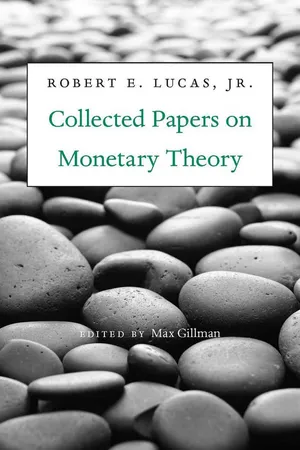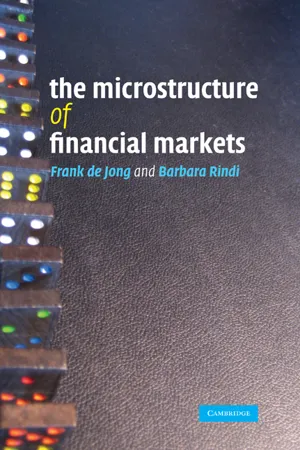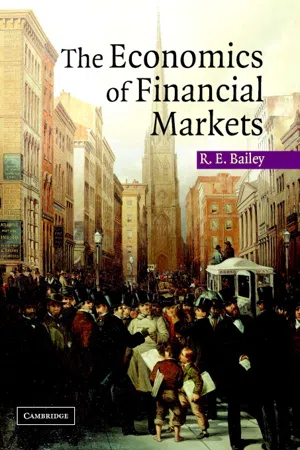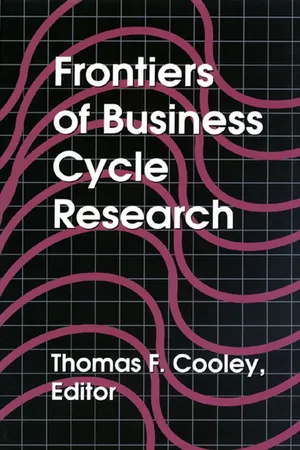Economics
Asset Market Equilibrium
Asset market equilibrium refers to the point at which the demand for and supply of financial assets, such as stocks and bonds, are in balance. At this equilibrium, the price of the assets reflects all available information and there is no incentive for investors to change their portfolios. This concept is crucial for understanding the pricing and allocation of financial assets in the economy.
Written by Perlego with AI-assistance
Related key terms
1 of 5
5 Key excerpts on "Asset Market Equilibrium"
- eBook - ePub
- Robert E. Lucas Jr., Max Gillman, Robert E. Lucas, Jr., Robert E Lucas, Max Gillman(Authors)
- 2013(Publication Date)
- Harvard University Press(Publisher)
2Asset Prices in an Exchange Economy
1. Introduction1This paper is a theoretical examination of the stochastic behavior of equilibrium asset prices in a one-good, pure exchange economy with identical consumers. The single good in this economy is (costlessly) produced in a number of different productive units; an asset is a claim to all or part of the output of one of these units. Productivity in each unit fluctuates stochastically through time, so that equilibrium asset prices will fluctuate as well. Our objective will be to understand the relationship between these exogenously determined productivity changes and market determined movements in asset prices.Most of our attention will be focused on the derivation and application of a functional equation in the vector of equilibrium asset prices, which is solved for price as a function of the physical state of the economy. This equation is a generalization of the Martingale property of stochastic price sequences, which serves in practice as the defining characteristic of market “efficiency,” as that term is used by Fama [7] and others. The model thus serves as a simple context for examining the conditions under which a price series’ failure to possess the Martingale property can be viewed as evidence of non-competitive or “irrational” behavior.The analysis is conducted under the assumption that, in Fama’s terms, prices “fully reflect all available information,” an hypothesis which Muth [13] had earlier termed “rationality of expectations.” As Muth made clear, this hypothesis (like utility maximization) is not “behavioral”: it does not describe the way agents think about their environment, how they learn, process information, and so forth. It is rather a property likely to be (approximately) possessed by the outcome - eBook - PDF
- Robert E. Lucas Jr., Max Gillman, Robert E. Lucas, Jr., Robert E Lucas, Max Gillman(Authors)
- 2013(Publication Date)
- Harvard University Press(Publisher)
25 . 2 . Asset Prices in an Exchange Economy 1. Introduction 1 This paper is a theoretical examination of the stochastic behavior of equi-librium asset prices in a one-good, pure exchange economy with identical consumers. The single good in this economy is (costlessly) produced in a number of different productive units; an asset is a claim to all or part of the output of one of these units. Productivity in each unit fluctuates stochasti-cally through time, so that equilibrium asset prices will fluctuate as well. Our objective will be to understand the relationship between these exoge-nously determined productivity changes and market determined move-ments in asset prices. Most of our attention will be focused on the derivation and application of a functional equation in the vector of equilibrium asset prices, which is solved for price as a function of the physical state of the economy. This equation is a generalization of the Martingale property of stochastic price sequences, which serves in practice as the defining characteristic of market “efficiency,” as that term is used by Fama [7] and others. The model thus serves as a simple context for examining the conditions under which a price series’ failure to possess the Martingale property can be viewed as evidence of non-competitive or “irrational” behavior. Econometrica 46, no. 6 (November 1978): 1429–1445. 1. This paper originated in a conversation with Pentti Kouri, who posed to me the prob-lem studied below. I would also like to thank Yehuda Freidenberg, Jose Scheinkman, and Joseph Williams for many helpful comments. - eBook - PDF
- Frank de Jong, Barbara Rindi(Authors)
- 2009(Publication Date)
- Cambridge University Press(Publisher)
2 Financial market equilibrium As we observed in the Introduction, the purpose of this book is to discuss models of price formation that discard some of the assumptions of the traditional asset pricing approach. We shall start by removing the hypothesis of symmetric information and assess the relevance of adverse selection costs in asset pricing theory. To this end, after a brief introductory discussion of the importance of asymmetric information and the related new concept of rational expectations equilibrium, we start from a very simple model of asset pricing with symmetric information and then introduce models with asymmetric information, where prices are vehicles of information and where this role of prices is central to the analysis. When traders use market prices to learn about the future value of an asset, by trading they affect the informational efficiency of the market, which ultimately depends on traders’ preferences and the number and types of agents. This chapter starts with a simple general framework in which a representative risk- averse agent allocates his wealth between a risk-free and a risky asset. The model is then extended to the case where the representative agent can choose to distribute his wealth among N risky assets; this will allow us to obtain the equilibrium asset prices that are consistent with the capital asset pricing model (CAPM) approach. Finally, we will introduce asymmetric information and show how equilibrium asset prices reflect public as well as private information. This model will be solved under the assumptions of both naïve and rational expectations. On the assumption of rational expectations we will present a model in the spirit of Grossman and Stiglitz (1980). Finally, we will discard the hypothesis that agents do not take the effect of their own trading strategies on the market price into account, assuming instead that agents behave strategically. To this end, we will present a simplified version of Kyle’s (1989) model. - eBook - PDF
- Roy E. Bailey(Author)
- 2005(Publication Date)
- Cambridge University Press(Publisher)
3. In frictionless markets the absence of arbitrage opportunities enables definite predic-tions about how asset prices are linked together. 4. Rates of return are typically quoted at annual rates. But investors may have horizons greater or less than a year and may revise their decisions many times before the horizon is reached. 24 The economics of financial markets 5. Asset market efficiency is a concept open to different interpretations. Several aspects of efficiency have been introduced, the two most commonly encountered in financial economics being (a) informational efficiency (that asset prices reflect available infor-mation) and (b) operational efficiency (that asset markets function according to the tenets of industrial efficiency). Further reading Many textbooks in finance contain substantial amounts of introductory material. For a thorough coverage, either of the following is worth consulting: Elton, Gruber, Brown and Goetzmann (2003, chaps. 1–3); or Sharpe, Alexander and Bailey (1999, chaps. 1–3). Tobin and Golub (1998) cover much of the subject matter of financial economics with a different emphasis, namely that of placing the subject in the context of monetary economics and banking. Students of modern finance swiftly realize that a grasp of mathematics is necessary to progress very far. Cvitani´ c and Zapatero (2004) offer a textbook exposition in which mathematical methods find prominence. The coverage of chapter 1 of their book is similar to that here. Subsequent chapters of the book, while in a different sequence from that adopted here, explore many of the same topics, though with significantly greater emphasis on the relevant mathematics. The contributions comprising Crane et al. (1995) pursue in depth the func-tional perspective outlined in section 1.1; chapter 1 is especially interesting. A comprehensive description of financial institutions appears in Kohn (2004). - eBook - PDF
- Thomas F. Cooley(Author)
- 2020(Publication Date)
- Princeton University Press(Publisher)
Chapter 10 Asset Pricing Implications of Equilibrium Business Cycle Models K. Geert Rouwenhorst 1. Introduction Research problems on the boundary of finance and macroeconomics are rapidly emerging as central to the evolution of each field. In finance it is now well es-tablished that expected returns on securities do not depend on idiosyncratic risks, but rather on nondiversifiable components, as predicted by the standard Capital Asset Pricing Model (C APM) of Sharpe (1964) and Lintner (1965). There is much less agreement on which aggregate factors are relevant to the determinants of ex-pected returns or how these factors change over time. Rather, detailed analysis of asset pricing issues requires a general equilibrium model, as stressed by Cox, Ingersoll, and Ross (1985) and Breeden (1986). In macroeconomics, much re-cent research has been oriented toward development and simulation of small-scale dynamic equilibrium models, as in Kydland and Prescott (1982) and Long and Plosser (1983), but few papers have explored the asset pricing relationships of these general equilibrium macroeconomic models. 1 A frequently debated issue in finance has been whether discount rates or ex-pected returns are sufficiently constant to permit application of the CAPM of Sharpe (1964) and Lintner (1965) in research and decisionmaking. The early literature on stock price volatility, for instance, suggested that stock prices were too volatile relative to the present value of dividends, discounted at a constant rate (LeRoy and Porter 1981, Shiller 1981). Although most finance scholars will agree that discount rates vary over time, relatively little work has been done toward understanding the extent to which they vary, and the sources of this variation. Recently, a large number of authors have argued that there exists important variation in expected returns and return variances, and that this variation is linked to the stages of the business cycle.
Index pages curate the most relevant extracts from our library of academic textbooks. They’ve been created using an in-house natural language model (NLM), each adding context and meaning to key research topics.




